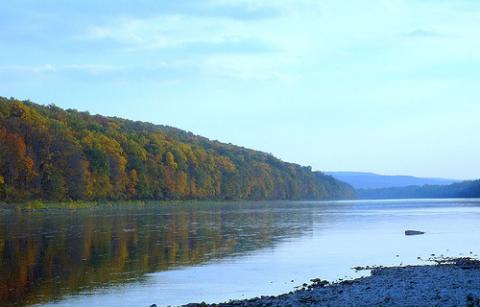Delaware Water Gap National Recreational Area, on the Pennsylvania—New Jersey border west of New York City, is a popular location for "float trips" in the northeastern United States. On a nice September day, a couple I'll call Jack and Jill decided to take a canoe trip on the Delaware River. At the time, it must have seemed like a good idea.
Jack and Jill rented a canoe from a local outfitter and headed to Smithfield Beach to start their adventure. Their destination—a spot called Kittatinny Point—was only six miles downstream, and under typical conditions was an easy three-hour trip.
The canoe rental employee arranged to meet the pair later that afternoon and shuttle them back to their car. I hope their shuttle driver took a good book along when he headed for the pickup point, because "typical conditions" apparently took the day off.
The couple's destination featured an extra advantage for boaters who were not familiar with the territory: It was located just downstream from the Interstate 80 Bridge, a landmark which would be hard for even novice paddlers to miss. On any river trip, overshooting a take-out point can have consequences ranging from inconvenient to catastrophic, depending upon what lies downstream and how far it is to the next spot where boaters can safely end their trip.
Jack and Jill probably had in mind a quiet, relaxing day, drifting lazily down the river and enjoying some early fall color as they were carried gently along by the current. They'd paddle a little now and then, but wouldn't work up a serious sweat. This stretch of the Delaware River doesn't have anything that would qualify as major rapids, but occasional riffles might add just a hint of excitement to the trip.
Our couple embarked on their mini-adventure, but after six hours of steady paddling there was no sign of the seemingly elusive I-80 Bridge. They'd already journeyed for twice as long as expected, and perhaps had concluded that this canoeing business was a lot harder than it looked on those TV shows touting "fun and easy outdoor getaways within a day's drive of home." What could possibly have gone wrong?
Jill said later, "When we reached the fourth set of rapids and the water was still going the 'wrong' way, we decided we had probably been going the wrong way." Perhaps they figured that the first three sets of rapids had been a little confused, and the situation would change if they just hung in there a little longer.
Optimism is an admirable quality, but in this situation the odds were heavily stacked against the couple due to something called "Newton's Law of Gravity." Among its implications is the fact that water in a free-flowing, natural state on Planet Earth will always run downhill, leading to this corollary of Newton's law: The river always runs downstream.
One commonly accepted definition of the term "canoeing" is "to travel by canoe down a river." The absence of a strong current in the river may have caused some confusion, but after launching their canoe, Jack and Jill had clearly made just one mistake. It was, however, a biggie: They headed upstream instead of downstream.
This is a good spot to offer some free outdoor trip advice, although I realize for many people it goes against the grain of the Independent American Spirit: When navigation is in doubt, just stop and ask for directions. Right at the top of the list of must-know river trip information is a very important detail: downstream is thataway.
Lacking that essential data, this trip was destined from the outset to qualify as a Melancholy Situation. Finally accepting their error, the couple turned around and paddled back downstream for another ninety minutes. At least the going was finally a lot easier!
Alas, by now light was quickly fading, and Jack and Jill made their best decision of the day: pull over to shore and wait for morning. Stopping where you are and waiting for help is always the right call on any trip to the Great Outdoors if you're (1) faced with darkness, (2) haven't the slightest clue where you are, and (3) have absolutely no idea how far it is to your destination, even if it's something as obvious an interstate highway bridge.
In a final touch of irony, our couple didn't realize they ended their voyage only about a hundred yards upstream from the point where they had started, over seven hours earlier! The Proper Authorities were notified when the pair didn't arrive at their take-out point, park rangers began a search, and the missing boaters were found in good shape in pitch darkness.
While another Jack and Jill intentionally went up a hill, our duo mistakenly went up a river with the best of intentions but the worst of directions. Plenty of people have a poor sense of direction, especially in the out-of-doors, but I trust that on any future trips, this pair will at least take time to be sure they know which way is up.
This story is adapted from the book Hey Ranger 2: More True Tales of Humor and Misadventure from the Great Outdoors © Jim Burnett and Taylor Trade Publishing, used by permission.




Comments
People with this lack of experience should not be out alone ----- travel with others to gain knowledge before heading out alone.